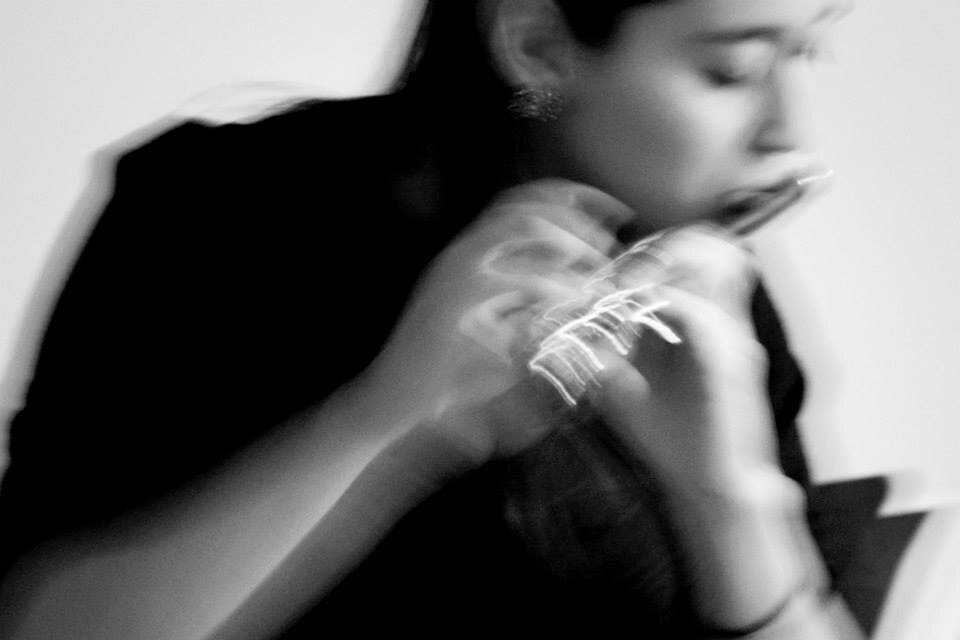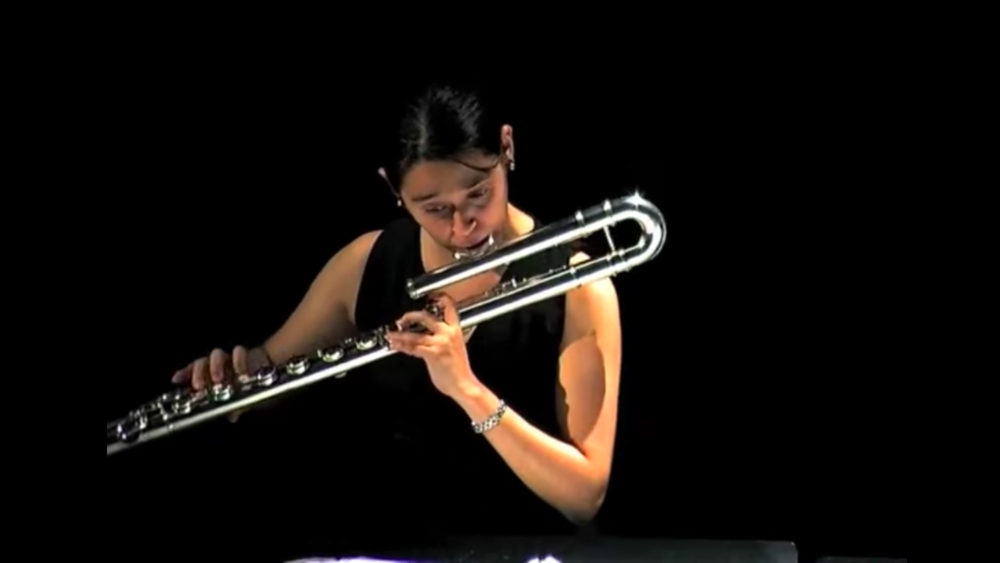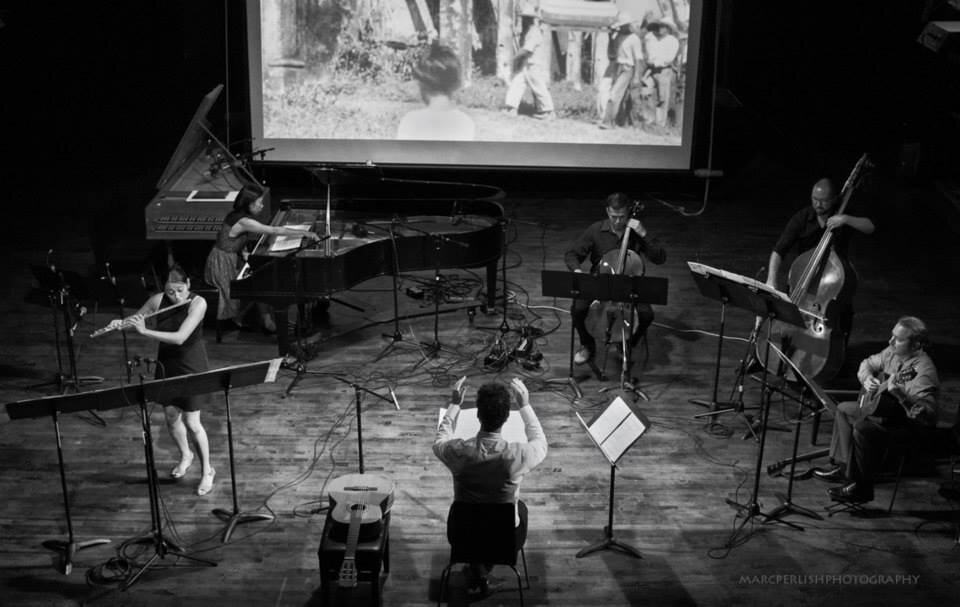Borrowing Narratives and Intimacy in Collaboration: my music for flute
By Pablo Santiago Chin
For me, composing for the clarinet and the flute poses greater challenges than working with other instruments. The former because it is my own instrument, and I feel at risk of reproducing a limited knowledge that I have internalized over the years: an obstacle to the discovery of unthinkable possibilities which I find more joyful. The latter, because its technical and expressive possibilities seem exhausted in the past 60 years, and because I grew up listening to my sister playing the core of flute repertoire (including orchestral excerpts), making the instrument all too familiar to me. But composing for my sister was even more frightening, if not intimidating, due to this closeness. It took us about 7 years since she played my music for the first time to engage in a deep and close collaboration that resulted in Three Burials for flute and quartet. An overview of my pieces for flute over the past years will reveal both the evolution of important trends in my musical language, especially the role of narrative, and the development of a long term collaboration with my sister that found real depth until my most recent piece for flute, Three Burials (2015).
Along with the voice, the flute occupies a prominent place in my body of work. Dalia Chin, my sister and Fonema Consort's flutist, has a close proximity to the composition of my pieces highlighting the flute, which recently culminated in a collaborative triptych based on scenes of old films depicting funerals. Three Burials recalls musical allegories of the ritual of mourning. As in Brian Ferneyhough's Funerailles (from French, funerals) in which two movements [1] born from the same seed are separated by one or more other pieces, the flute part of Three Burials consists of two solo pieces--the latter being an alternative composition of the former--interspersed by a contrasting second movement not involving the flute. The piece can be played as a solo (in which case other pieces can be programmed in between the two solos) or with an additional quartet of cello, double bass, piano and guitar.
The most remarkable thing about these solo pieces is the process of composing them. A recording of two Peruvian indigenous melodies entitled triste (from Spanish, sad) was transcribed by Dalia to best suit the Western flute. The result was a series of recurring multiphonics. Then I subjected these multiphonics, as they appear in Dalia's transcription, to a tortuous journey of distortions that give shape to each piece. Quotes from Ravel's Pavane pour une infante défunte (movement III, 1’58”) and Revueltas' funeral scene from Redes appear in the quintet version (movement I, 4’30”):
Three Burials, movement I
In Three Burials Dalia took a leading role in the actual composition of the piece, whereas in previous collaborations we embraced more traditional roles of composer and performer: the former creates while the latter interprets. Dalia and I first came to know each other’s work in depth after the very first Fonema performance in 2011: Sólo es real la niebla (Only the Fog is Real). In setting a short poem by Octavio Paz to music, the flute was ideal to portray the illusion of fog through airy sounds (a technique unrivaled by any other instrument), and to team with the saxophone and voice in exploring plosives and other percussive sounds to echo the sound of steps at the heart of the poem.
Along with Sólo es real la niebla, since 2011 Dalia has revisited a flute duo I had composed for WIRED (the former flute section of ICE) in 2009 titled Como la leyenda de Ixquiq. For the first time in this piece I explored a wide array of trendy contemporary techniques such as tongue clicks and tongue ram, airy sounds and microtones as well as smorzato and overblown high clusters. Experiencing each of Dalia’s several performances of the piece gave me a very palpable understanding of these techniques, beyond the theoretical descriptions of methods on contemporary flute performance.
While the exchange of musical ideas between Dalia and I was slowly evolving from 2009 to 2011, my musical language was increasingly focusing in borrowing narratives from other artistic media. Similarly to how Sólo es real la niebla toys with various ways to text-paint Paz’s poem, the flute duo borrows the narrative of a legend from the Popol Vuh (the sacred book of the Quiché Indians of Mesoamerica) to define and organize its music material. According to the tale, Hun-Hunahpú had been turned into a tree by the Sirs of Xibalbá (the underworld). When young maiden Ixquiq, out of curiosity, descended to the underworld to grab the precious fruits of the mythical tree, Hun-Hunahpú spit into the palm of her right hand. His saliva contained his descendants, and that is how legendary heroes Hunahpú and Ixbalanqué were conceived. Like in the legend of Ixquiq, this piece was born out of the “saliva” of three notes: an overblown altissimo C-sharp foreshadowing the piccolo at the end of the piece; the opening middle G initiating the process of register expansion; and a F-pizzicato that gradually proliferates, and has been suggested by listeners to resemble Hun-Hunahpú spitting into Ixquiq’s hand.
Como la leyenda de Ixquiq
The flute duo introduced to my music an incipient exploration of physical space as a means to reinforce the perception of form. As the register expands throughout the piece to the outer registers of the flute family, the flutists gradually spread towards the extremes of the stage as they follow their scores over several stands. Spatialization later became the germ from which I composed a flute concerto of sorts, In the Form of a Shell (2013). Using the flute as a starting point, the distribution of the orchestra spirals around the soloist in exponentially greater instrumental groupings, ending with a string ensemble placed on the left side of the stage, thus mimicking the shape of a Nautilus shell. This piece was commissioned by conductor David Cubek and flutist Ysmael Reyes. Later Dalia had the opportunity to give the Costa Rican premiere of the piece with the Symphony Orchestra of Heredia (OSH) and recently with the orchestra of University of Wisconsin-Whitewater (UWW), stepping forward into the process of assimilating my music.
In addition to exploring the notion of space in this piece, I tested the possibilities of independently composed parts co-existing with each other. The flute part can be performed as a solo piece (Dalia gave its premiere at Constellation Chicago in 2014). In the solo version titled Inside the Shell, the details in the crafting of the flute sounds can be further appreciated. It is with the orchestral part, however, that the piece achieves greater expression. While the flute progresses from a stream of hectic and energetic musical lines to more static ones that eventually dissolve into sporadic jet whistles, the orchestra reverses that process, journeying from stasis to a cathartic 2-minute Coda featuring a feast of quick repeated beats and flurries that celebrate the dissolution of the soloist part. This formal approach contrasting two reversed processes is reminiscent of Saariaho’s Verblendungen (1984) in which “the tape part begins with noisy, rhythmical material and ends with a quasi-orchestral luminosity made up of violin sounds. Conversely, the instrumental sounds take on a more and more noisy texture until they are completely lost in the quasi-orchestra of the magnetic tape.” [2]
In the Form of a Shell
Leftover material from Inside the Shell became the main source materal for four miniatures for flute. Each miniature is shorter than the preceding one, creating an overall trajectory while also focusing on four contrasting characteristics of Inside the Shell. As in the previously discussed pieces, these miniatures also evoke a narrative. They are reflections upon a photograph by a dear friend, Marc Perlish, depicting piles of books from the bookshelves of the former Bookman’s Alley in downtown Evanston, IL. Before closing after 33 years in 2013, Marc paid tribute to the charm of the bookstore by exhibiting a series of photos of Bookman’s Alley. Then he commissioned local composers to create a piece based on a photo from his series. After glancing at my chosen photo I imagined myself immersing myself in random pages of four books from these endless piles. Hence the title Libros de Marc (Marc’s books). I finished writing this piece just in time for Dalia’s birthday in March 2014 and gave it to her as a present. This was the preceding stage before realizing it was about time to compose a piece with (and not just for) Dalia: Three Burials. At the same time I had accumulated enough works pointing towards narrative as a major focus in my music’s aesthetics.
Libros de Marc
It is evident that my music often comes from an examination of the narratives of non-musical art, whether a poem, a legend, a photograph or a film. Essential features of my works are also influenced by musicians and artists for whom I compose. Delving into the chronology of my music for flute allowed me to uncover the evolution of these two trends over the past 7 years, reaching their most accomplished form in Three Burials. From the standpoint of narrative this piece manages to weave a broad variety of references to burials, to film and to my own music. These references can be as subtle as the second movement featuring 71 descending microtonal clusters as a secret homage to Michael Haneke’s 71 Fragments of a Chronology of Chance, or as immediate as the cello ending the first movement with the A-C-A motif of Revuelta’s funeral scene in Redes.
From the vantage point of collaborating with musicians, with Three Burials I was able to develop strategies to give up a certain compositional control, in order to allow Dalia to be an active agent in defining the sound world of the piece. By having her transcribe recordings of a Peruvian indigenous flute according to how she hears those sounds and adapt them to her most intrinsic way of relating to her instrument, I was able to access part of her inner self. Transcription, as translation, can be seen as the making of something new that resembles something that already exists (that which is transcribed or translated). [3] I perceive Dalia’s transcription of the indigenous Peruvian recordings as her appropriation of those songs, that later I also appropriated in finalizing the piece. Furthermore, together Dalia and I found ways to distort the series of multiphonics she came up with in ways that married my desired notions of sounds to the most personal way in which she physically embodies the instrument.
Three Burials, movement III
Growing up, Dalia and I’s musical paths did not cross in significant ways. When she entered the undergraduate program at the University of Costa Rica I had left it to continue studying at Florida International University in Miami. When she entered the master’s program at Florida State University I had left to pursue a doctoral degree at Northwestern University. Finally I had settled down in Chicago and she moved to the windy city to study at DePaul University. Then we co-founded Fonema Consort. While at first our paths were like the chasing subjects of a fugue, now they are like the patterns of Steve Reich’s phase music, intermittently merging to embark in joint projects. Three Burials was the most recent one and a turning point in my work, opening windows for developing new possibilities in my musical language and especially in my understanding of the meaning of collaboration.
Footnotes
[1] In his program note to Funerailles, Ferneyhough refers to “two ‘Versions’ [that] can be considered neither as two movements of the same work nor as two distinct works.”
[2] Saariaho, Kaija. “Timbre and harmony: interpolations of timbral structures.” Contemporary Music Review 2.1 (1987): 122. Print
[3] In his essay Translation: literature and letters Octavio Paz remarks that “each text is unique, yet at the same time it is the translation of another text. No text can be completely original because language itself, in its very essence, is already a translation–first from the nonverbal world, and then because each sign and each phrase is a translation of another sign, another phrase. However, the inverse of this reasoning is also entirely valid. All texts are originals because each translation is a creation and thus constitutes a unique text.” Octavio Paz. ‘Translation: Literature and Letters”. Transl. Irene del Corral, in Rainer Schulte and John Biguenet (eds), Theories of Translation: An Anthology of Essays from Dryden to Derrida (Chicago, Illinois: University of Chicago Press, 1992): 154. Print




